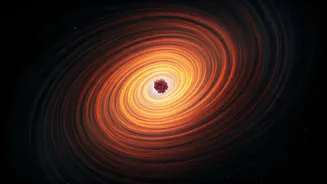Lensing Reveals All
Astronomers have employed a technique called gravitational lensing to uncover the existence of a tiny dark matter clump. This method capitalizes on the way
massive objects warp the fabric of space-time, causing light to bend as it passes by. By analyzing the distortions in light from distant galaxies, scientists could infer the presence of dark matter, even though it does not emit light. The tiny clump, undetectable by any direct method, revealed itself through these subtle shifts in the light's path. The method enabled researchers to see the minute effects of dark matter. This method, a testament to Einstein's theory of general relativity, allows astronomers to observe objects that would otherwise remain hidden from view.
Cosmic Distance Defined
The diminutive dark matter clump resides approximately 10 billion light-years from Earth. This enormous distance underscores the exceptional sensitivity of the instruments used in the observation and the significance of the discovery. Each light-year, a measure of distance, is roughly equivalent to 5.88 trillion miles (9.46 trillion kilometers). The sheer scale emphasizes the vastness of the cosmos and the challenges involved in studying distant objects. The feat highlights the advancements in observational astronomy. Its discovery also prompts the question: how could this tiny clump have remained unseen for so long, and what new revelations might similar, further-reaching investigations bring?
What is Dark Matter?
Dark matter, making up roughly 85% of the universe's matter, remains a profound mystery. It neither absorbs nor emits light, making it invisible to conventional telescopes. Its existence is primarily inferred from its gravitational effects on visible matter, such as galaxies and stars. This gravitational pull provides the basis for astronomers to understand dark matter, even without direct observation. The behavior and properties of dark matter are not clearly understood. The discovery of a tiny dark matter clump provides the possibility of gaining greater insights into the nature of dark matter and the structure of the cosmos.
Implications and Outlook
The detection of this smallest dark matter clump offers new insights into how dark matter is distributed throughout the universe. This helps refine models about the universe. Such findings help to understand how galaxies have formed and evolved. Future investigations, including more sophisticated telescopes and analysis methods, could potentially reveal even smaller dark matter structures and provide further clues about its elusive nature. These future breakthroughs promise to expand the borders of current knowledge and could possibly rewrite some of the understanding about dark matter. Furthermore, these studies may help to understand the universe and its formation.








